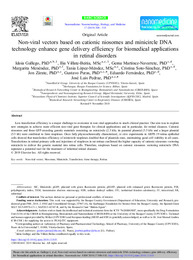Please use this identifier to cite or link to this item:
https://hdl.handle.net/11000/34590Full metadata record
| DC Field | Value | Language |
|---|---|---|
| dc.contributor.author | Gallego , Idoia | - |
| dc.contributor.author | Villate Beitia, Ilia | - |
| dc.contributor.author | Martínez-Navarrete, Gema | - |
| dc.contributor.author | Menéndez, Margarita | - |
| dc.contributor.author | López-Méndez, Tania | - |
| dc.contributor.author | Soto-Sánchez, Cristina | - |
| dc.contributor.author | Zárate, Jon | - |
| dc.contributor.author | Puras, Gustavo | - |
| dc.contributor.author | Fernández, Eduardo | - |
| dc.contributor.author | Pedraz, José Luis | - |
| dc.contributor.other | Departamentos de la UMH::Histología y Anatomía | es_ES |
| dc.date.accessioned | 2025-01-16T17:40:05Z | - |
| dc.date.available | 2025-01-16T17:40:05Z | - |
| dc.date.created | 2019-04-17 | - |
| dc.identifier.citation | Nanomedicine . 2019 Apr:17:308-318 | es_ES |
| dc.identifier.issn | 1748-6963 | - |
| dc.identifier.uri | https://hdl.handle.net/11000/34590 | - |
| dc.description.abstract | Low transfection efficiency is a major challenge to overcome in non-viral approaches to reach clinical practice. Our aim was to explore new strategies to achieve more efficient non-viral gene therapies for clinical applications and in particular, for retinal diseases. Cationic niosomes and three GFP-encoding genetic materials consisting on minicircle (2.3 kb), its parental plasmid (3.5 kb) and a larger plasmid (5.5 kb) were combined to form nioplexes. Once fully physicochemically characterized, in vitro experiments in ARPE-19 retina epithelial cells showed that transfection efficiency of minicircle nioplexes doubled that of plasmids ones, maintaining good cell viability in all cases. Transfections in retinal primary cells and injections of nioplexes in rat retinas confirmed the higher capacity of cationic niosomes vectoring minicircle to deliver the genetic material into retina cells. Therefore, nioplexes based on cationic niosomes vectoring minicircle DNA represent a potential tool for the treatment of inherited retinal diseases. | es_ES |
| dc.format | application/pdf | es_ES |
| dc.format.extent | 11 | es_ES |
| dc.language.iso | eng | es_ES |
| dc.publisher | Elsevier | es_ES |
| dc.rights | info:eu-repo/semantics/openAccess | es_ES |
| dc.rights.uri | http://creativecommons.org/licenses/by-nc-nd/4.0/ | * |
| dc.subject | non-viral vector | es_ES |
| dc.subject | niosomes | es_ES |
| dc.subject | minicircle | es_ES |
| dc.subject | transfection | es_ES |
| dc.subject | gene therapy | es_ES |
| dc.subject | retina | es_ES |
| dc.title | Non-viral vectors based on cationic niosomes and minicircle DNA technology enhance gene delivery efficiency for biomedical applications in retinal disorders | es_ES |
| dc.type | info:eu-repo/semantics/article | es_ES |
| dc.relation.publisherversion | 10.1016/j.nano.2018.12.018 | es_ES |

View/Open:
Non-viral vectors based on cationic niosomes and minicircle DNA technology enhance gene delivery efficiency for biomedical applications in retinal disorders.pdf
2,91 MB
Adobe PDF
Share:
.png)
